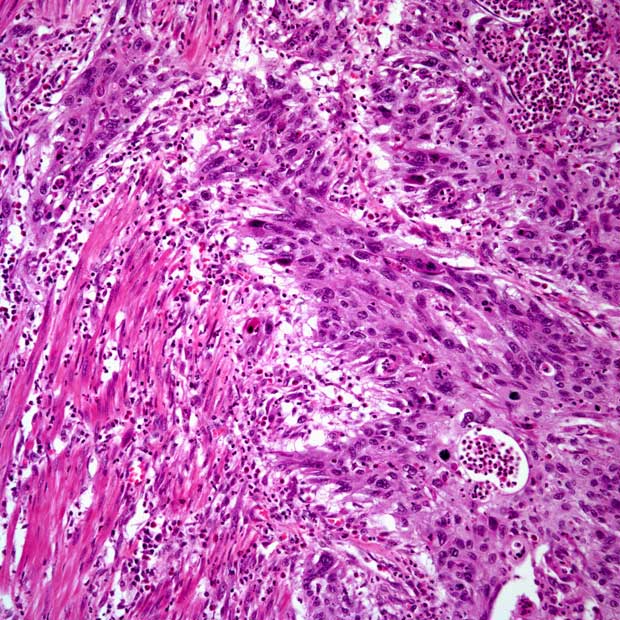Cretostimogene Grenadenorepvec Yields Durable Responses in NMIBC
More than half of the patients with non–muscle-invasive bladder cancer in the BOND-003 trial achieve a complete response at 6 months following treatment with cretostimogene grenadenorepvec.
The next steps for the BOND-003 trial (NCT04452591) involve the treatment extension phase and the addition of a papillary-only cohort.

More than three quarters of the population with high-risk BCG-unresponsive non–muscle-invasive bladder cancer (NMINC) had a complete response following treatment with cretostimogene grenadenorepvec, according to findings from the phase 3 BOND-003 trial (NCT04452591) presented during the 2023 Society of Urologic Oncology (SUO) Annual Meeting.1
“Based on central review, 75.7% (95% CI, 63-85) of patients reached a complete response at any time point. The responses were durable with 74.4% of the complete responses lasting for at least 6 months,” Mark Tyson, MD, MPH, a urologic oncologist at the Mayo Clinic, said when presenting the data.
To enroll in the BOND-003 trial, patients had to have pathologically confirmed high-risk NMIBC with CIS +/- Ta/T1 that is unresponsive to BCG treatment; an ECOG performance status of 0 to 2; and not be eligible for or refuse to receive a radical cystectomy. Patients were required to have all Ta/T1 disease resected prior to receiving treatment.
Overall, 116 patients with BCG-unresponsive high-risk NMIBC have been enrolled on the trial, and the efficacy data presented at the SUO meeting were from the interim analysis of the first 66 patients at a cutoff date of October 5, 2023.
The 66 patients comprised 50 males and 16 females. The median patient age was 73 years (range, 49-90). Eighty percent of patients were aged >65 years. Fifty-three patients (80%) had an ECOG performance status of 0 and 13 patients (20%) had an ECOG performance status of 1. The median number of prior BCG instillations was 14.4 (range, 7-14). Regarding staging, 2 patients had CIS with T1, 10 patients had CIS with Ta HG, and 54 patients had CIS.
In the study design, the oncolytic immunotherapy is administered beginning with a weekly induction regimen lasting 6 weeks. This is followed by 3 weekly maintenance instillations at months 3, 6, 9, 12, and 18. Patients who continue to have high-grade disease at 3 months are eligible to receive a re-induction regimen of 6 weeks of weekly cretostimogene grenadenorepvec.
Notably, data from the interim analysis showed that 31% of patients who did not respond to their first course of treatment were able to be salvaged with re-induction.
The primary end point of the trial is the rate of complete responses achieved at any time on study. Secondary end points include the complete response rate at 12 months, duration of response, progression-free survival, cystectomy-free survival, and safety.
The complete response rate at 3 months was 68.2% (n = 45) and the complete response rate at 6 months was 63.6% (n = 42).
The safety population included 112 patients. Most adverse events (AEs) were grade 1/2. The most common treatment-related AEs (TRAEs) were bladder spasm (20.5%), pollakiuria (16.1%), dysuria (14.3%), micturition urgency (11.6%), and hematuria (10.7%).
Two patients (1.8%) experienced grade 2 serious TRAEs and no patients had grade ≥3 TRAEs. There were no treatment-related discontinuations and no patient deaths.
The next steps for BOND-003 involve the treatment extension phase and the addition of a papillary-only cohort. The phase 3 PIVOT-006 study is also launching. This trial is comparing Transurethral Resection of Bladder Tumor (TURBT) followed by adjuvant cretostimogene grenadenorepvec versus TURBT followed by observation for the treatment of participants with intermediate-risk NMIBC.
Tyson also noted that cretostimogene grenadenorepvec has received FDA Fast Track Designation for the treatment of patients with BCG-unresponsive CIS with or without Ta/T1 papillary disease.
Commenting on the findings in a press release, Trinity J. Bivalacqua, MD, PhD, professor of Urology and Oncology at the Perelman Center for Advanced Medicine, University of Pennsylvania, said, “The positive BOND-003 initial results demonstrate the impact of cretostimogene in BCG-unresponsive disease patients as a promising new monotherapy which may lead to profoundly meaningful non-surgical outcomes for those with recurrent bladder cancer. NMIBC has been a difficult disease to treat, and patients have often had no options except surgical removal of the bladder.”2
References
- Tyson M, Uchio E, Jong-Kil N, et al. First results from BOND-003, a Phase 3 study of intravesical Cretostimogene grenadenorepvec monotherapy for patients with high-risk BCG- unresponsive Non-Muscle Invasive Bladder Cancer. Presented at: 2023 Society of Urologic Oncology Annual Meeting. November 28 – December 1, 2023; Washington, DC. LBA3396.
- CG Oncology. Cretostimogene Grenadenorepvec Monotherapy First Results Show 75.7% Complete Response Rate at Any Time in Patients With High-Risk BCG-Unresponsive Non-Muscle-Invasive Bladder Cancer. Published online and accessed November 30, 2023. https://tinyurl.com/mb6kud69
Newsletter
Stay up to date on recent advances in the multidisciplinary approach to cancer.